
Félix Ziem stands as a unique and highly successful figure in the landscape of 19th-century French art. Born Félix-Francois Georges Philibert Ziem, his long and prolific career bridged the gap between the Barbizon School's romantic naturalism and the burgeoning Impressionist movement's fascination with light and atmosphere. Renowned primarily for his luminous depictions of Venice and Constantinople (modern-day Istanbul), Ziem captured the imaginations of collectors and critics alike, achieving remarkable fame and fortune during his lifetime. His work, characterized by vibrant color, dynamic brushwork, and an almost dreamlike quality of light, continues to enchant viewers today. He was an artist deeply influenced by his travels, translating the sun-drenched vistas of the Mediterranean and the exotic allure of the East onto his canvases with unparalleled flair.
Early Life and Architectural Beginnings
Félix Ziem was born on February 26, 1821, in Beaune, located in the Burgundy region of France. His heritage was mixed; his mother hailed from Burgundy, while his father was an immigrant, originally from Croatia. This diverse background perhaps hinted at the cosmopolitan life he would later lead. Initially, Ziem's path seemed destined for a different creative field altogether: architecture. He pursued formal studies in this discipline at the École des Beaux-Arts in Dijon from 1837 to 1839.
Following his education, Ziem relocated to the bustling port city of Marseille in 1839. There, he found work, initially leveraging his architectural training by serving as an engineer or construction supervisor. It was during his time in Marseille, amidst the vibrant light and maritime activity of the Mediterranean coast, that Ziem began to explore painting, initially as a pastime alongside his architectural duties. This early exposure to the unique quality of southern French light would prove formative for his later artistic development. The transition from the structured world of architecture to the more fluid medium of paint began to take shape.
The Call of Venice and the East

A pivotal moment in Ziem's artistic journey occurred around 1841. An inspirational trip to Italy, particularly to Venice, ignited his passion for painting and solidified his decision to dedicate himself fully to art. The shimmering canals, decaying grandeur, and unique atmospheric light of Venice captivated him profoundly. This first encounter marked the beginning of a lifelong love affair with the city, which would become his most famous and frequently revisited subject. Venice offered him an inexhaustible source of motifs, from grand vistas of the Bacino di San Marco to intimate canal scenes bathed in morning mist or sunset glow.
Ziem's wanderlust did not stop at Italy. He became an inveterate traveler, seeking inspiration across Europe and beyond. Between 1843 and 1845, he journeyed to Russia, spending nearly two years in Saint Petersburg, where he associated with Prince Grigori Gagarin, himself an artist and art enthusiast. This experience broadened his horizons further. His travels frequently took him to Constantinople, the gateway to the Orient, whose exotic architecture, bustling waterways like the Golden Horn and the Bosphorus, and vibrant street life provided a rich counterpoint to his Venetian scenes. These journeys were not mere sightseeing trips; they were fundamental to his artistic practice, providing the raw material and sensory experiences that fueled his distinctive style.
Artistic Style: Light, Color, and Atmosphere
Félix Ziem developed a highly personal and recognizable artistic style, distinguished by its emphasis on light, color, and atmospheric effects. While associated with the Barbizon School, his approach often transcended its more grounded naturalism, incorporating a romantic sensibility and prefiguring Impressionist concerns. He was a master at capturing the specific quality of light in different locations – the hazy, golden light of Venice, the sharp, clear light of the Mediterranean, or the dramatic effects of sunrise and sunset over the Bosphorus.
Ziem's technique involved using vibrant, often unmixed colors applied with energetic, visible brushstrokes. He frequently employed thin layers of paint, or glazes, to build up luminosity and depth, sometimes leaving areas of the canvas or paper bare to suggest the brilliance of highlights. This handling of paint gave his works a sense of immediacy and vibrancy. His compositions often focused on water and sky, allowing him ample opportunity to explore reflections and the play of light. While artists like Claude Monet would later take the study of transient light effects even further, Ziem was undoubtedly a pioneer in making light itself a primary subject of his paintings. His work skillfully blends topographical accuracy with a heightened, almost dreamlike, emotional response to the scene.
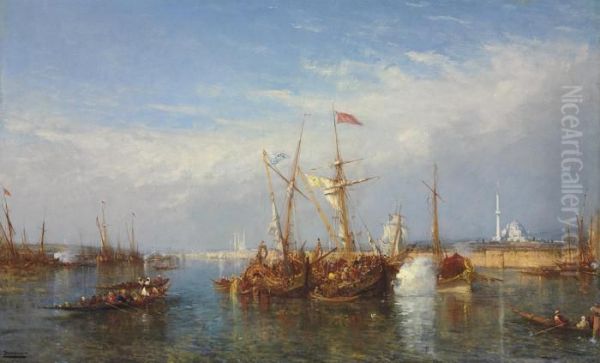
He worked proficiently in both oil and watercolor, often achieving similar effects of luminosity and fluidity in both mediums. His watercolors, in particular, possess a remarkable transparency and brilliance. Ziem's fascination with the effects of light and his bold use of color clearly set him apart from many of his contemporaries and marked him as an important precursor to the Impressionist revolution, even if he never formally joined their ranks. His style was less about objective recording and more about conveying the feeling and visual splendor of a place.
The Barbizon Connection
During the mid-19th century, Félix Ziem became associated with the Barbizon School, a loose collective of artists who worked in and around the village of Barbizon, near the Forest of Fontainebleau. This group, which included prominent figures like Jean-Baptiste-Camille Corot, Jean-François Millet, Théodore Rousseau, and Charles-François Daubigny, reacted against the Neoclassical formalism dominating the French Academy. They championed a return to nature, emphasizing realistic depictions of the landscape, often painted directly outdoors (en plein air), although studio finishing was common.
Ziem shared the Barbizon painters' interest in landscape and natural effects, but his subject matter often differed. While many Barbizon artists focused on the rustic French countryside, Ziem's gaze was frequently turned towards more exotic or celebrated locales like Venice and Constantinople. However, his approach to capturing atmosphere and light aligned with the Barbizon ethos. He established connections with several members of the group. For instance, evidence suggests he collaborated with Charles-François Daubigny, known for his river scenes often painted from a boat studio, in Jouarre. After moving to Paris around 1849, Ziem also connected with artists like Constant Troyon, known for his animal paintings within landscapes, and Jean-François Millet, famous for his depictions of peasant life.
His association with the Barbizon School provided him with a supportive artistic environment and positioned him within a significant movement in French art history. It helped establish his reputation as a serious landscape painter, even as his unique style, influenced by his travels and fascination with brilliant light, set him somewhat apart. He absorbed the Barbizon emphasis on direct observation but infused it with his own romantic and colorful vision.
Venice: The Enduring Muse
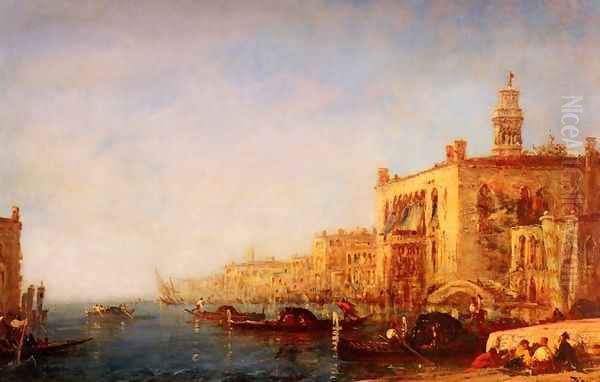
No location is more synonymous with Félix Ziem than Venice. From his first visit in the early 1840s until late in his life, the city remained his most profound and enduring source of inspiration. He returned countless times, drawn by its unique combination of architectural splendor, watery reflections, and ever-changing atmospheric conditions. Venice offered a perfect stage for his artistic preoccupations with light, color, and water. He painted the city's famous landmarks – the Doge's Palace, St. Mark's Basilica, Santa Maria della Salute – but often focused on the interplay of light on the water of the Grand Canal or the Bacino di San Marco.
Ziem's dedication to capturing the essence of Venice was extraordinary. Anecdotes tell of him living and working directly on a boat, possibly a gondola or small barge, during extended stays in 1844-1845. This allowed him to observe the city from unique vantage points and experience its moods intimately, from the quiet stillness of dawn to the bustling activity of midday and the dramatic colors of sunset. He saw Venice not just as a picturesque subject but, as he reportedly described it, a "port of life," a place brimming with history, beauty, and a certain melancholic charm.
His Venetian paintings became incredibly popular and sought-after. Works like Venice: the Bacino di S. Marco with Fishing Boats exemplify his ability to combine topographical detail with a vibrant, almost theatrical, presentation. He captured the festive spirit of the city as well as its more tranquil moments, always emphasizing the shimmering quality of light reflecting off the water and illuminating the facades of ancient palazzi. His Venice was often an idealized vision, bathed in golden light, evoking a sense of timeless romance and splendor that resonated deeply with 19th-century audiences.
Constantinople and Oriental Visions
Alongside Venice, Constantinople held a special place in Ziem's artistic imagination. His travels to the Ottoman capital provided him with a wealth of exotic subjects that tapped into the 19th-century European fascination with the "Orient." He was captivated by the city's dramatic skyline, dominated by mosques like the Hagia Sophia, its bustling waterways – the Golden Horn and the Bosphorus – teeming with caiques and sailing vessels, and its vibrant street life. His depictions of Constantinople contributed significantly to the genre of Orientalist painting, offering Western audiences evocative glimpses of this distant and alluring world.
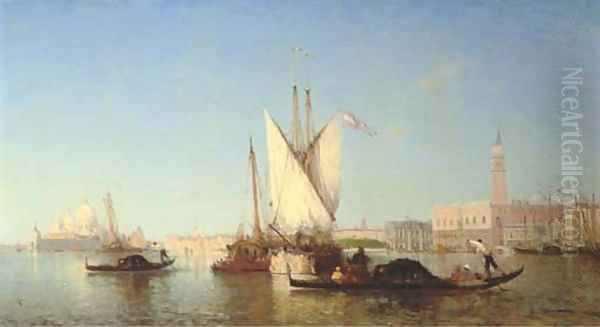
Ziem painted Constantinople numerous times; records suggest he created as many as 142 works featuring the city. He approached it with the same sensitivity to light and atmosphere that characterized his Venetian scenes. Works such as Istanboul, le soleil couchant (Istanbul at Sunset) showcase his mastery of dramatic lighting, capturing the city silhouetted against a fiery sky. Constantinople, Hagia Sophia at Sunrise presents the iconic structure bathed in the soft, warm light of dawn, emphasizing its monumental presence. Paintings like Harbour in Constantinople (likely depicting the Golden Horn) and Bosphorus with Boats focus on the maritime life that was central to the city's identity, using dynamic brushwork to convey the movement of water and vessels.
His Orientalist works, while sometimes romanticized, were often based on direct observation during his travels. He skillfully balanced architectural detail with atmospheric effects, conveying both the grandeur of the city's landmarks and the energy of its daily life. These paintings were highly successful, appealing to the public's taste for the exotic and further cementing Ziem's reputation as a painter of international scope. His contribution lies in bringing his signature style – luminous, colorful, and atmospheric – to these Eastern subjects.
A Bridge to Impressionism?
Félix Ziem occupies an interesting position in the transition from mid-19th-century realism and romanticism towards Impressionism. While never formally part of the Impressionist group – he continued to exhibit regularly at the official Paris Salon long after the Impressionists began holding their independent exhibitions – his work clearly anticipates many of their concerns. His fascination with capturing the effects of natural light, his use of vibrant color, and his often loose, energetic brushwork all resonate with Impressionist aesthetics.
Artists like Claude Monet, arguably the quintessential Impressionist, certainly would have been aware of Ziem's work, particularly his popular Venetian scenes. Ziem's emphasis on light as a primary subject and his attempts to render its fleeting qualities prefigure Monet's own obsessive studies of light at different times of day, famously seen in his series paintings of Rouen Cathedral or Haystacks. Other Impressionists, such as Auguste Renoir, known for his dappled light effects, and perhaps Camille Pissarro, with his focus on landscape and atmosphere, may also have found aspects of Ziem's approach intriguing. Even Edgar Degas, though more focused on modern urban life and the figure, shared an interest in capturing momentary effects, albeit in different contexts.
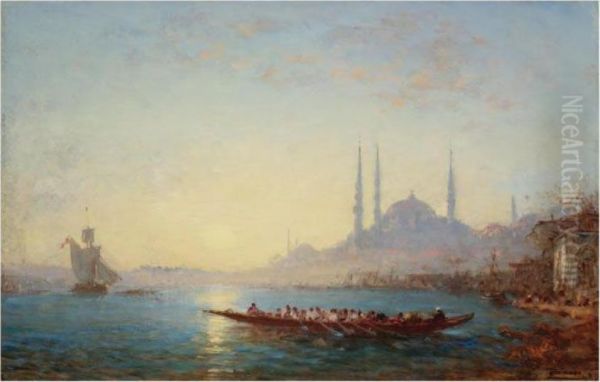
However, key differences remained. Ziem's work often retained a more structured compositional sense and a romanticized, sometimes idealized, view of his subjects, compared to the Impressionists' commitment to capturing the immediate, objective sensation of a scene. Ziem interpreted reality through a highly personal lens, aiming for evocative beauty, whereas the core Impressionists were more focused on the optical experience of light and color in a specific moment. Despite these distinctions, Ziem's pioneering exploration of light and color undoubtedly helped pave the way for the Impressionist revolution. His influence extended beyond his immediate successors; remarkably, even a modern master like Pablo Picasso is said to have admired and been influenced by Ziem's handling of color and light early in his career.
Success, Recognition, and the Market
Félix Ziem achieved a level of commercial success and official recognition rare for artists of his time. His debut at the Paris Salon in 1849 was well-received, and he quickly became a regular and popular exhibitor, winning several medals over the years. His luminous and appealing paintings, particularly those of Venice, struck a chord with both critics and the public. This popularity translated into significant financial success. Ziem was astute in managing his career and finances, keeping detailed records that distinguished between his artistic income and capital gains, reflecting a keen awareness of the burgeoning capitalist economy.
His market value soared, especially from the late 1860s onwards. Records indicate that between 1865 and 1873, the prices for his Venetian scenes doubled, while those depicting Marseille or nearby Martigues increased sixfold. He cultivated relationships with influential art dealers, who played a crucial role in promoting his work and connecting him with wealthy patrons and collectors across Europe and America. Figures like Paul Durand-Ruel, famous for championing the Impressionists, were active during Ziem's peak years, and while direct links need careful verification, the ecosystem of dealers was vital to Ziem's success.
A crowning achievement came when the French state acquired one of his paintings for the Musée du Luxembourg (whose collections later transferred to other national museums, including the Louvre). This made Félix Ziem the first living artist to have his work enter the Louvre's collection, a tremendous honor that solidified his status within the French art establishment. His works continued to command respectable prices at auction throughout his life and beyond. For example, a significant Venetian scene fetched around $300,000 in 2009, and estimates for good quality works remain substantial, demonstrating continued collector interest, even if the majority of his vast output trades at more modest levels today. His success story highlights the possibility for an artist in the 19th century to achieve both critical acclaim and significant commercial prosperity.
Later Life and Legacy

Ziem remained active as an artist well into his old age. His life was punctuated by historical events, such as the Franco-Prussian War of 1870-71. During the conflict and the subsequent Paris Commune, his studio in Montmartre, a hub for artists, was unfortunately destroyed. Seeking refuge, he spent time in the South of France, continuing to paint despite the turmoil. He later purchased a villa in Nice, another sun-drenched Mediterranean location that suited his artistic temperament. For many years, he divided his time between Paris, his studio in Martigues (near Marseille), Nice, and his beloved Venice, maintaining his prolific output.
Despite his enduring popularity and financial success, Ziem's later work sometimes faced criticism. Some commentators felt that his style became formulaic and repetitive, driven more by market demand for his signature Venetian and Oriental scenes than by genuine artistic innovation. His early works are often considered his most inventive. This critique highlights a tension faced by many successful artists: balancing artistic integrity with commercial pressures. Nevertheless, his overall contribution remained significant.
Félix Ziem died in Paris on November 10, 1911, at the venerable age of 90. He was buried in the prestigious Père Lachaise Cemetery in Paris, the final resting place of many celebrated figures. He left behind an immense body of work, estimated at over 10,000 paintings and drawings, encompassing not only his famous landscapes but also still lifes and portraits. His legacy lies in his mastery of light and color, his evocative depictions of Venice and the East, and his unique position as a bridge between the Barbizon School and Impressionism. He demonstrated that landscape painting could be both romantically expressive and commercially viable on a grand scale.
Collections and Academic Study
The importance and appeal of Félix Ziem's work are reflected in its presence in numerous major museum collections around the world. Beyond the Louvre in Paris, his paintings can be found in institutions such as the Musée d'Orsay (which houses many works formerly in the Luxembourg and Louvre), the Petit Palais in Paris, the Hermitage Museum in Saint Petersburg, the National Gallery of Art in Washington D.C., the Art Institute of Chicago, and the Victoria and Albert Museum in London, among others. This widespread institutional recognition underscores his historical significance.
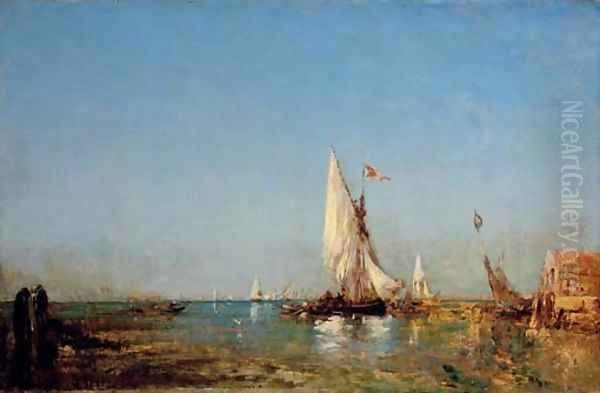
Dedicated study of Ziem's life and work continues. The Musée Ziem in Martigues, located in a region he frequented and painted, is devoted to his art and legacy, housing a significant collection of his works and related archival materials. Academic research has explored various facets of his career. Art historians like Pierre Miquel have published comprehensive monographs detailing his biography and artistic development. More recent scholarship, such as that by Léa Saint-Raymond, has delved into his business practices and relationship with the art market, shedding light on the socio-economic context of his success. Exhibitions dedicated to his work continue to be organized, offering opportunities for reassessment and appreciation.
These collections and ongoing studies ensure that Félix Ziem remains a subject of interest for art historians and the public. They allow for a deeper understanding of his techniques, his influences, his place within 19th-century art movements, and his enduring ability to capture the magic of light on water and architecture.
Conclusion
Félix Ziem was more than just a painter of beautiful places; he was a painter obsessed with the transformative power of light. His canvases, whether depicting the sun setting over the Grand Canal in Venice or rising over the mosques of Constantinople, are infused with a luminosity and atmospheric depth that was groundbreaking for its time. As a key figure associated with the Barbizon School, he embraced naturalism but pushed it towards a more romantic and color-rich expression. His work served as an important precursor to Impressionism, exploring themes and techniques that would become central to the movement, even though he maintained his own distinct artistic identity and path to success through the official Salon system.
His phenomenal success, marked by prestigious awards, acquisition by the Louvre during his lifetime, and a thriving market for his work, speaks to his ability to connect with the tastes and aspirations of his era. While sometimes criticized for commercialism in his later years, his vast output and the consistent quality of his best work secure his place as a major figure in 19th-century European art. Félix Ziem remains celebrated for transporting viewers to sunlit worlds, capturing the enduring allure of Venice and the exotic charm of the East with a brush dipped in light itself. His legacy endures in the countless shimmering canvases that continue to captivate audiences in museums and collections worldwide.